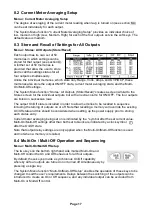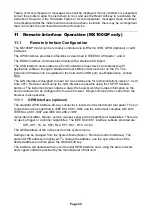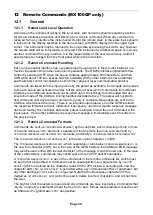
Page 23
However, this time could be increased if the current setting is very low or is very close to the
current required by the load. A large external capacitance at the load could also slow down the
response.
When switching off with no load, the output will normally fall back to zero within a fixed length of
time (see section 14 – Specifications). If a load is connected the response may be quicker
because of the additional discharge provided by the load. However, if the load includes a large
capacitance the response may be slower.
Turn-on and turn-off speeds are particularly relevant to Multi-On/Multi-Off output sequencing
(see section 8.4) where delays between the switching of different outputs can be set to a
resolution of 10ms. These delays apply only to the initiation of an output being turned on or
turned off, the actual delay will depend upon the actual turn-on or turn-off times applying as
described above. In situations where the user needs to know the actual response speeds for
specific conditions it will be necessary to observe this using an oscilloscope.
10.7
Using OVP and OCP
OVP (over-voltage protection) monitors the voltage on the output terminals and switches the
output off if it exceeds the OVP setting. The response speed is typically 100us. Control of OVP
is described in section 0.
OVP might be used to guard against accidental mis-setting of the power supply or might be
used to identify a fault condition when operating in constant current mode. Unlike the voltage
limit setting, exceeding the OVP will turn the output off in a situation where damage to the
device under test might otherwise occur.
OCP (over-current protection) monitors the current flowing at the output and switches the output
off if it exceeds the OCP setting. The response speed is <0.5s. Control of OCP is described in
section 0.
OCP might be used to guard against accidental mis-setting of the power supply or might be
used to identify a fault condition when operating in constant voltage mode. Unlike the current
limit setting, exceeding the OCP will turn the output off in a situation where damage to the
device under test might otherwise occur.
10.7.1 OCP Trip at Output On
If the OCP level is set to a very low level whilst also being below the set current level, it is
possible for a trip condition to be created when the output is switched on. This is caused by the
current needed to charge the output capacitance. Whether a trip occurs is a function of the
OCP trip response speed, the OCP level, the set current and the set output voltage.
10.8
Over-temperature Trip (OTP)
The power supply has a sensor that monitors the internal ambient temperature. Should that
exceed a safe level, as might occur if the ventilation input or output was blocked, an over-
temperature protection trip (OTP) will occur. Should OTP occur, all four outputs will be turned
off and an OTP message will appear on the screen. Normal operation can only be restored by
turning the AC supply (Power) off, rectifying the ventilation problem and allowing the unit to cool
before switching back on.
Also, each output module has a temperature sensor which can shut down only the affected
output and display an OTP message. In this case it is possible to attempt to clear the trip
condition without requiring a power cycle using the Reset soft-key. If the OTP message
continues to be displayed after allowing the module to cool this may be an indication of a
hardware fault.
In addition, there is a temperature sensor on the power device of the PFC (power factor
correction) stage. If this detects an over-temperature problem, all power outputs will shut down;
the auxiliary supply for the CPU and display will, however, remain active, and the ‘Hardware
















































